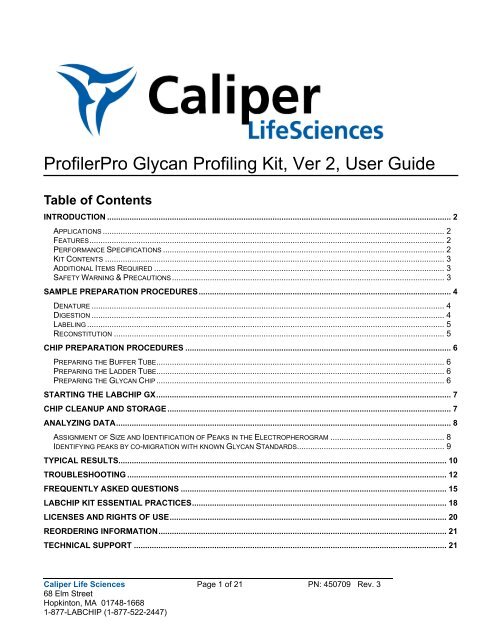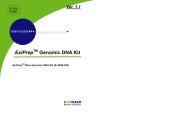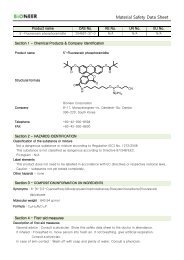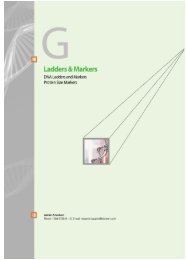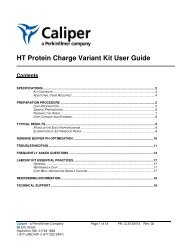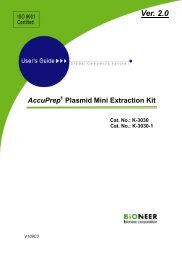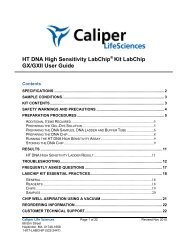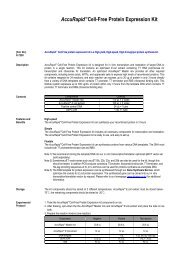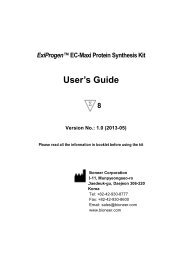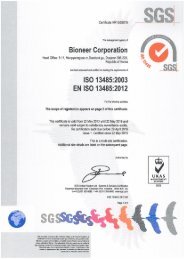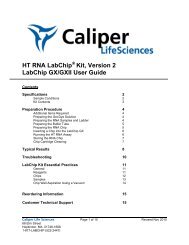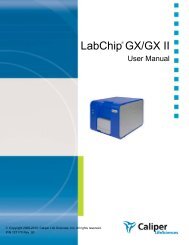ProfilerPro Glycan Profiling User Guide - PerkinElmer
ProfilerPro Glycan Profiling User Guide - PerkinElmer
ProfilerPro Glycan Profiling User Guide - PerkinElmer
You also want an ePaper? Increase the reach of your titles
YUMPU automatically turns print PDFs into web optimized ePapers that Google loves.
<strong>ProfilerPro</strong> <strong>Glycan</strong> <strong>Profiling</strong> Kit, Ver 2, <strong>User</strong> <strong>Guide</strong>Table of ContentsINTRODUCTION .......................................................................................................................................................... 2APPLICATIONS ......................................................................................................................................................... 2FEATURES ............................................................................................................................................................... 2PERFORMANCE SPECIFICATIONS .............................................................................................................................. 2KIT CONTENTS ........................................................................................................................................................ 3ADDITIONAL ITEMS REQUIRED .................................................................................................................................. 3SAFETY WARNING & PRECAUTIONS .......................................................................................................................... 3SAMPLE PREPARATION PROCEDURES ................................................................................................................. 4DENATURE .............................................................................................................................................................. 4DIGESTION .............................................................................................................................................................. 4LABELING ................................................................................................................................................................ 5RECONSTITUTION .................................................................................................................................................... 5CHIP PREPARATION PROCEDURES ....................................................................................................................... 6PREPARING THE BUFFER TUBE ................................................................................................................................. 6PREPARING THE LADDER TUBE................................................................................................................................. 6PREPARING THE GLYCAN CHIP ................................................................................................................................. 6STARTING THE LABCHIP GX .................................................................................................................................... 7CHIP CLEANUP AND STORAGE ............................................................................................................................... 7ANALYZING DATA ...................................................................................................................................................... 8ASSIGNMENT OF SIZE AND IDENTIFICATION OF PEAKS IN THE ELECTROPHEROGRAM ................................................... 8IDENTIFYING PEAKS BY CO-MIGRATION WITH KNOWN GLYCAN STANDARDS .................................................................. 9TYPICAL RESULTS ................................................................................................................................................... 10TROUBLESHOOTING ............................................................................................................................................... 12FREQUENTLY ASKED QUESTIONS ....................................................................................................................... 15LABCHIP KIT ESSENTIAL PRACTICES .................................................................................................................. 18LICENSES AND RIGHTS OF USE ............................................................................................................................ 20REORDERING INFORMATION ................................................................................................................................. 21TECHNICAL SUPPORT ............................................................................................................................................ 21Caliper Life Sciences Page 1 of 21 PN: 450709 Rev. 368 Elm StreetHopkinton, MA 01748-16681-877-LABCHIP (1-877-522-2447)
<strong>ProfilerPro</strong> <strong>Glycan</strong> <strong>Profiling</strong> Kit, Ver 2, <strong>User</strong> <strong>Guide</strong>IntroductionApplicationsThe <strong>ProfilerPro</strong> <strong>Glycan</strong> <strong>Profiling</strong> system provides a high throughput method for analysis of the glycosylationpatterns of monoclonal antibodies (MAb) and other glycosylated proteins. The system provides methods for: 1)deglycosylation, where N-linked glycans are released enzymatically using PNGase F; 2) fluorescent labeling ofthe released glycans in presence of released proteins; 3) separation by microchip based capillary electrophoresis(CE); and 4) detection and analysis using the LabChip GXII instrument. Fast separation time–less than 45seconds per sample—makes this method valuable for use in high throughput screening of antibody glycosylationpatterns in early stage development.The microchip based CE analysis gives resolution sufficient to determine the relative abundance of the major N-glycan types found on antibodies, which containprimarily neutral N-linked glycans consisting ofcomplex, hybrids, and high-mannose typeoligosaccharides.Features• Fast separation time – less than 45 secondsper sample, about 1.5 hours for 96 samples.• Software determines the relative amounts ofeach glycan present.• All included reagent set, providespredictable, reproducible results.• Reagents provided in 96-well plate formatfor convenience and ease of automation.• Automatic sampling from a 96-well plate.Performance SpecificationsGlycosylation profile of a therapeutic MAb. Relative abundanceof the major glycan types can be reliably quantified.Amount of sample required:8μl with concentration range of 1.25mg/ml to 7.5mg/ml(10μg to 60μg of MAb total).Reproducibility of %area: CV < 10% for a peak >= 2.5% of total glycan.Limit of detection:1ng of G0f standard. (Smallest amount of labeled G0fstandard that can be detected.)Deglycosylation: >95% of all N-Linked glycans will be released from MAb.Usable size range:Appropriate for neutral glycans found on MAbs. Somecharged glycans may run outside of our usable range.Sizing reproducibility: CV < 2.5%Carryover:< 0.5% of previous sample can be detected in followingsample.Sample prep, chip prep, and < 8 hours for a 96-well plate.analysis time:Number of samples per chip prep:Up to 192 samples before chip needs to be reloaded withfresh gel.Number of samples per chip Up to 384 samples before chip needs to be replaced.lifetime:Caliper Life Sciences Page 2 of 21 PN: 45070968 Elm StreetHopkinton, MA 01748-16681-877-LABCHIP (522-2447)
Kit ContentsThe <strong>ProfilerPro</strong> <strong>Glycan</strong> <strong>Profiling</strong> system consists of:<strong>ProfilerPro</strong> <strong>Glycan</strong> <strong>Profiling</strong> Kit, Ver 2, <strong>User</strong> <strong>Guide</strong><strong>Glycan</strong> Release and Labeling Kit (part number 760523)• Denaturing Plate (96-samples) for denaturing glycoprotein prior to digestion by PNGase F.• PNGase F Plate (96-samples) for releasing the oligosaccharides.• Dye Plate (96-samples) for labeling the oligosaccharides.• Store at -20CHT High Resolution LabChip (part number 760524)• HT High Resolution Chip. Good for 400 samples.• Chip cleaning consumables kit.• Store at 4C.HT <strong>Glycan</strong> LabChip Reagent Kit (part number 760525)• HT <strong>Glycan</strong> Gel Matrix Solution, 2 tubes.• HT <strong>Glycan</strong> Marker (dry), 4 tubes.• HT <strong>Glycan</strong> Marker Diluent, 1 tube.• HT <strong>Glycan</strong> Ladder (dry), 4 tubes.• HT <strong>Glycan</strong> Ladder Diluent, 1 tube.• Enough for 4 chip preps.• Store at 4C.Additional Items Required• LabChip GXII instrument with LabChip GX software version 2.2 or greater. May be downloaded fromhttp://www.caliperls.com/support/software-downloads.htm• GX Plate Adapter for Deep-Well PCR Plates (part number 126209).• Heating device: any PCR thermocycler is best. A heat block that accepts a 96-well PCR plate will alsowork. An incubator may work, but is less desirable.• Adhesive Plate seals. (PCR type with a minimum thermal range of -20C to 80C. For example, BeckmanCoulter 538619, Axygen PCR-AS-200).• Centrifuge with rotor that accepts a 96-well PCR plate.• Optional: Plate shaker (for example: VarioMag Magnetic Shaker, Cat. 51110, 2,000 rpm, Amplitude =2mm).Safety Warning & Precautions! WARNING ! For Research Use Only. Not recommended or intended for diagnosis of disease inhumans or animals. Do not use internally or externally in humans or animals.CAUTION We recommend that this product and components be handled only by those who have beentrained in laboratory techniques and that it is used in accordance with the principles of good laboratorypractice. As all chemicals should be considered as potentially hazardous, it is advisable when handlingchemical reagents to wear suitable protective clothing, such as laboratory overalls, safety glasses, andgloves. Care should be taken to avoid contact with skin or eyes. In case of contact with skin or eyes, washimmediately with water.! WARNING ! Denaturing Buffer, Ladder, and Gel Matrix contain SDS. Avoid inhalation and contactwith skin and eyes.Caliper Life Sciences Page 3 of 21 PN: 45070968 Elm StreetHopkinton, MA 01748-16681-877-LABCHIP (522-2447)
Sample Preparation Procedures<strong>ProfilerPro</strong> <strong>Glycan</strong> <strong>Profiling</strong> Kit, Ver 2, <strong>User</strong> <strong>Guide</strong>8μL sample(1.25 to 7.5mg/mL mAb)Denature for10min at 70C.Transfer ~11μLof denature.Digest for1hr at 37C.Transfer 8μLof digest.Label for2hrs at 55C.Reconstituteand run.Denaturing Plate PNGase F Plate Dye Plate LabChip GXIIDenature1. Thaw and spin Denaturing Plate at 1200g for 1 minute.2. Carefully remove the plate seal.3. Add 8μL of sample (monoclonal antibody) with concentrationrange of 1.25mg/mL to 7.5mg/mL (10μg to 60μg total protein)to Denaturing Plate. Mix by pipetting up and down or with aplate shaker.a. Samples should be at least one step purified.Crude sample media or buffers that containsugars may interfere with the labeling efficiency ofthe desired glycans.b. For a control blank sample add 8μL of moleculargrade water instead of sample and follow alldigestion and labeling steps.4. Seal plate carefully with an adhesive plate seal. (Note:Ensure the plate is completely sealed to prevent evaporation.)5. Spin Denaturing Plate at 1200g for 1 minute.6. Incubate Denaturing Plate for 10 minutes at 70C using a PCRmachine (with lid temperature at 70C), heat block, orincubator.Digestion1. Thaw PNGase F Plate.2. Spin both PNGase F Plate and Denaturing Plate at 1200g for1 minute.Hints:Spin-down: All plates must be spundown before removing the seal to collectany reagent that may be attached to theplate seal.Cutting the Plates: If less than 72 wellsin a plate will be used at one time the 96-well Denaturing, PNGase-F, and DyePlates can be cut vertically into sectionsof 24, 48, or 72-wells. To cut plates, firststack it on top of a 96-well skirted PCRplate for support. Using an X-Acto, knifecut the plate seal above where the platewill be cut. Then score and cut thedesired flat portion of the plate along thesegmented groove. Using scissors cutthe wall of the plate. (Note: Be carefulnot to cut or crack the plate wells. Aftercutting inspect all plate wells for cracks.Do not use wells with cracks.)Storage: If not using a whole 96-wellDenaturing, PNGase F, or Dye Plate,after cutting the plate freeze theremainder immediately. This isespecially critical for the Denaturing Plateas it contains DTT.Partial Plates: When working withpartial or cut plates it’s helpful to stackthe plate on top of a 96-well skirted PCRplate for support, especially whenspinning.Caliper Life Sciences Page 4 of 21SPN: 45070968 Elm StreetHopkinton, MA 01748-16681-877-LABCHIP (522-2447)
<strong>ProfilerPro</strong> <strong>Glycan</strong> <strong>Profiling</strong> Kit, Ver 2, <strong>User</strong> <strong>Guide</strong>3. Carefully remove plate seals.4. Transfer all (~11μL) denatured sample to PNGase F Plate. Mixby pipetting up and down or with a plate shaker.5. Seal plate carefully with an adhesive plate seal. (Note: Ensurethe plate is completely sealed to prevent evaporation.)6. Spin PNGase F Plate at 1200g for 1 minute.7. Incubate for 1 hour at 37C using a PCR machine (with lidtemperature at 37C), heat block, or incubator.Labeling1. Thaw Dye Plate.2. Spin both Dye Plate and PNGase F Plate at 1200g for 1 minute.3. Carefully remove plate seals.4. Transfer 8μL of Digested sample to the Dye Plate. Mix bypipetting up and down or with a plate shaker.5. Spin Dye Plate at 1200g for 1 minute.6. Incubate the unsealed plate for 2 hours at 55C (or until sampleis completely dry) using a PCR machine (with lid open) or heatblock. Caution: The dye contains acetic acid. Be wary offumes. Incubating under a fume hood is recommended.Sample must be completely dry to ensure sufficient labeling.Hints:Break point: If needed, after digestionsamples may be frozen at -20C andlabeled the next day. Overnightdigestion is not recommended.Incubators: Performing the incubationfor the labeling in an incubator or ovenis not recommended. If using anincubator for the labeling step, becareful of acetic acid fumes whenopening the incubator door. Also,carefully inspect samples to ensurethey are completely dry. It’s likely thatusing an incubator or oven willincrease the drying time to more than 2hours.Can more than 8μL of digestedsample be labeled?Sample buffer conditions resulting inoptimal glycan peak intensity wasobserved when labeling 8μL of thedigested sample. Labeling more orless will result in lower signal intensity.Break point: If needed, after labelingReconstitutiondried samples may be sealed andstored frozen at -20C and reconstituted1. Add 100μL of molecular grade water to dried samples.the next day. Overnight labeling is notrecommended.2. Seal plate carefully with an adhesive plate seal. (Note: Ensurethe plate is completely sealed to prevent spilling during mixing.)Mixing: It is best to use a plate shaker3. Mix samples on a plate shaker at maximum speed for at least 1 with max speed of at least 2000 rpm,minute. Check to be sure the pellet has completely dissolved.and Amplitude = 2mm for thereconstitution step If a plate shaker4. Spin plate at 1200g for 1 minute. (Note: After spinning there may be a white pellet at the bottom of the wells.Be careful not to disturb the pellet as it may cause a chip sipper clog.)5. Carefully remove plate seal and the plate is ready to run on your LabChip GXII.Caliper Life Sciences Page 5 of 21 PN: 45070968 Elm StreetHopkinton, MA 01748-16681-877-LABCHIP (522-2447)
<strong>ProfilerPro</strong> <strong>Glycan</strong> <strong>Profiling</strong> Kit, Ver 2, <strong>User</strong> <strong>Guide</strong>Chip Preparation ProceduresPreparing the Buffer Tube1. Add 750μL of molecular grade water to the 0.75mL Buffer Tube.2. Insert the Buffer Tube into the buffer slot on the LabChip GXII instrument.Buffer TubePreparing the Ladder Tube1. Add 145µL of Ladder Diluent to one of the Ladder tubes.2. Vortex at highest speed for about 30 seconds and spin down.3. Transfer 120μL of prepared ladder to the 0.2mL Ladder Tube. Avoid transferring anybubbles to the Ladder Tube.4. Insert the Ladder Tube into the ladder slot on the LabChip GXII instrument.LadderTubePreparing the <strong>Glycan</strong> Chip1. Remove reagents from all wells of the chip using a vacuum.2. Rinse and aspirate all wells with molecular grade water.Repeat, and be careful to aspirate all the water in the wells andany water that may have spilled onto the outside of the chip.3. Add 75μL of Gel Matrix to chip wells 2, 3, 7, 8 and 9, and120μL in well 10 using a Reverse Pipetting Technique.4. Prepare marker solution by adding 125µL of Marker Diluentto one of the Marker tubes. Vortex at highest speed forabout 30 seconds and spin down. Transfer 100μL of preparedmarker solution to chip well 4.5. Chip is ready to run on the LabChip GXII instrument.Hints:Chip and Gel Matrix: Equilibrate toroom temperature for about 20-30minutes before use.Marker Preparation: Prepare markersolution just before loading the chip inthe LabChip GXII and starting theassay. Do not prepare marker solutionin advance as the marker signaldegrades over time.Caliper Life Sciences Page 6 of 21 PN: 45070968 Elm StreetHopkinton, MA 01748-16681-877-LABCHIP (522-2447)
Starting the LabChip GX1. Start the LabChip GXII software.2. Place the chip in the LabChip GXII instrument.<strong>ProfilerPro</strong> <strong>Glycan</strong> <strong>Profiling</strong> Kit, Ver 2, <strong>User</strong> <strong>Guide</strong>3. Place the 96-well plate adapter (flat side down) in the instrument plate tray. Insert the sample plate intothe plate adapter.4. On the main screen, click on the Run button in the upper left corner of the LabChip GXII Software.5. The Start Run dialog box will pop up with tabs listed as Run, Output and Advanced.6. In the Run Tab, select HT <strong>Glycan</strong> Assay, Plate Name = 96-Deep Well PCR with Adapter, and set yourdesired well pattern.7. In the Output Tab select the File Location and File Format.8. In the Advanced Tab select the number of times each well is sampled and the inclusion of any samplenames.9. Click Start to begin the run.Chip Cleanup and Storage1. After use, the chip must be cleaned and stored in the chip container.2. Remove the reagents from each well of the chip using a vacuum.3. Each active well (1, 2, 3, 4, 7, 8, 9 and 10) should be rinsed and aspirated twice with molecular gradewater.4. Fill all wells with molecular grade water.5. Place the chip in the plastic storage container. The sipper should be submerged in the fluid reservoir.6. Cover the wells with Parafilm to prevent buffer evaporation and store the chip at 4C until next use.Caliper Life Sciences Page 7 of 21 PN: 45070968 Elm StreetHopkinton, MA 01748-16681-877-LABCHIP (522-2447)
<strong>ProfilerPro</strong> <strong>Glycan</strong> <strong>Profiling</strong> Kit, Ver 2, <strong>User</strong> <strong>Guide</strong>Analyzing DataAssignment of Size and Identification of Peaks in the ElectropherogramThe LabChip GX software analyzes the electropherograms, assigning a size (among other things) to eachobserved peak. It may not be intuitively obvious what this size means given that glycan molecules with thesame mass can sometimes have very different apparent electrophorectic mobility. During the labeling process,the glycans are derivatized with a charged fluorophore. The electrophorectic mobility of each glycan in ourspecific separation medium is dependent on its charge, mass, and structure—where structural elements suchas monosaccharide composition (mannose,glucose, galactose), glycosidic linkageposition (C2, C3, C4, C6), and anomercity(α- vs β-) have been shown to affectelectrophorectic mobility. Considering thesecomplexities, the size that the softwareassigns does not have a direct physicalmeaning, like the size of a DNA molecule inbase pairs or the size of a protein inDaltons. Rather, the sizes assigned toglycan peaks by the LabChip GX relate themigration time of each peak to the migrationtime of the glucose peaks in the glycanladder. It is a way of normalizing themigration time of each peak so that resultscan be more easily compared acrossdifferent runs, different instruments, differentreagent lots, etc.As an example, if a peak has a migrationtime half way between the 9-mer and 10-mer α(1-6)-linked glucoseoligosaccharides in the ladder, that peakwill be assigned a size of 9.5 CaliperGlucose Units (CGU). These units arespecific to the particular gel separationmatrix and the fluorophore that areprovided in the <strong>ProfilerPro</strong> <strong>Glycan</strong><strong>Profiling</strong> kits. They may not correspond toGlucose Units assigned by other analysismethods.The LabChip GX software allows the userto assign names to peaks based on theirsize. If you observe that the G0f peak inyour sample has a size of 9.3 CGU, youcan name the peak “G0f” using theAnalysis Settings dialog, Expected <strong>Glycan</strong>tab.The Ladder is a mixture of α(1-6)-linked glucose oligosaccharideswith various number of monomeric glucose units. Lower Marker (LM)and ladder peaks used for sizing (L) annotated with CGU units. TheLower Marker is maltohexaose which runs with a size of 6.6 CGU.Example of two standard curves that relate migration time to size in CaliperGlucose Units (CGU).Caliper Life Sciences Page 8 of 21 PN: 45070968 Elm StreetHopkinton, MA 01748-16681-877-LABCHIP (522-2447)
<strong>ProfilerPro</strong> <strong>Glycan</strong> <strong>Profiling</strong> Kit, Ver 2, <strong>User</strong> <strong>Guide</strong>Identifying peaks by comigration with known <strong>Glycan</strong> StandardsIt is sometimes interesting to compare the migration time of peaks observed in your samples to the migrationtime of known glycan standards, to help identify the peaks in your samples. When running glycan standards it isimportant that the buffer the standards are presented in is closely matched to the buffer your samples arepresented in. If the buffers are not well matched, the migration time of the standards may not correspond to themigration time of your sample. A simple method to achieve matched buffers is to label your standards using thereagents from the <strong>Glycan</strong> Release and Labeling kit, similar to the method used to prepare your test samples,but eliminating the denaturing and digestion incubation steps as shown in the diagram below. Any dilutions ofthe standards prior to addition in the Denaturing Plate should be done with molecular grade water.No incubation.No incubation.Label for2hrs at 55C.8μL standardsampleTransfer ~11μLof denature.Transfer 8μLof digest.Reconstituteand run.Denaturing Plate PNGase F Plate Dye Plate LabChip GXIILMG0G0fG2Man5G1f’’G1fG2fExample showing a mix of glycan standards compared to an IgG sample, run in well matched buffers.Blue = IgG, Red = Mix of six glycan standards (Man5, G0, G0f, G1f, G2, G2f). The standards were runat about 50 ng/µl concentration.Caliper Life Sciences Page 9 of 21 PN: 45070968 Elm StreetHopkinton, MA 01748-16681-877-LABCHIP (522-2447)
<strong>ProfilerPro</strong> <strong>Glycan</strong> <strong>Profiling</strong> Kit, Ver 2, <strong>User</strong> <strong>Guide</strong>Typical ResultsIn the <strong>Glycan</strong> Ladder the Lower Marker should be the tallest peak. Following the Lower Marker peak are 7 ladderpeaks with Caliper Glucose Units (CGUs) of 7 to 13.<strong>Glycan</strong> Ladder: Lower Marker (LM) and ladder peaks (L) annotated with CGU units.For monoclonal antibody samples the Lower Marker should migrate before the major N-glycan peaks (Man5, G0,G0f, G1f’, G1f, and G2f).MAb14: Major N-glycan peaks are annotated with percent area.Caliper Life Sciences Page 10 of 21 PN: 45070968 Elm StreetHopkinton, MA 01748-16681-877-LABCHIP (522-2447)
<strong>ProfilerPro</strong> <strong>Glycan</strong> <strong>Profiling</strong> Kit, Ver 2, <strong>User</strong> <strong>Guide</strong>MAb17: Major N-glycan peaks are annotated with percent area.Caliper Life Sciences Page 11 of 21 PN: 45070968 Elm StreetHopkinton, MA 01748-16681-877-LABCHIP (522-2447)
<strong>ProfilerPro</strong> <strong>Glycan</strong> <strong>Profiling</strong> Kit, Ver 2, <strong>User</strong> <strong>Guide</strong>TroubleshootingHow to test for complete digestionCaliper recommends testing for complete deglycosylation by PNGase F using the HT Protein Express assay.Compare the digested sample (unlabeled) to the undigested sample. Follow the protocol for the HT ProteinExpress Kit for reduced conditions. (Note: It may be necessary to dilute the digested sample depending on thestarting concentration. A starting concentration of 2mg/mL or below is recommended for the HT Protein Expressassay.) Under reduced conditions you will see a shift from the heavy chain (HC) to the non-glycosylated heavychain (NGHC) for the digested sample.Blue: control (undigested), Red: Digested MAbWhat if digestion is incompletePossible causes:1. The samples were incompletely denatured.2. There was an insufficient amount of PNGase F in the reaction.What to do:1. Repeat the sample preparation being careful to spin down the Denaturing Plate. Small amounts ofdenaturing buffer attached to the plate seal may significantly decrease the amount or concentration ofreagents needed to sufficiently denature samples. Additionally verify that the samples are beingdenatured at 70C for 10 minutes.2. If the sample tested was on the high end of the <strong>Glycan</strong> assay concentration range, then dilute sampledown to 5mg/mL and repeat sample preparation. Some MAbs may be more difficult to deglycosylate thanothers. In this event a greater amount of PNGase F to MAb may be need to completely deglycosylate.3. Repeat the sample preparation being careful to spin down the PNGase F Plate. Small amounts ofdigestion buffer attached to the plate seal may significantly decrease the available amount of PNGase F.Verify that the digestion is incubated at 37C for 1 hour.No peaks are found in the Ladder (sample and marker peaks are OK)There may be too low of a ladder volume or no ladder volume at all in the Ladder Tube. Try adding more ladderto the Ladder Tube and restart the run. Recommended standard ladder volume is 120µL (minimum requiredvolume is 100µL).Caliper Life Sciences Page 12 of 21 PN: 45070968 Elm StreetHopkinton, MA 01748-16681-877-LABCHIP (522-2447)
<strong>ProfilerPro</strong> <strong>Glycan</strong> <strong>Profiling</strong> Kit, Ver 2, <strong>User</strong> <strong>Guide</strong>No sample peaks (ladder is OK)There are several possible causes:1. The sipper is not reaching the sample due to low sample volume in the well plate, or wrong plate typeselected.2. The samples did not get labeled completely due to incomplete drying.3. If the missing sample peaks occurred only in a few wells of the plate, check those wells for air bubbles.4. Debris from the sample or sample prep is clogging the sipper.What to do:1. Make sure you have selected the Plate Type “96-Deep Well PCR with Adapter.” Verify the samplevolume is at least 100μL.2. Repeat the sample preparation procedures allowing the drying reaction to extend beyond 2 hours until thesamples are completely dry.3. Manually insert a larger volume pipette tip (~100µL) into the sample well and dislodge the bubble. Rerunthese sample wells.4. If you suspect there may be debris in your samples, spin the sample plate down in a centrifuge. Unclogthe sipper by repriming the chip. See the section entitled “LabChip Kit Essential Practices” forinstructions on how to reprime the chip.No sample or Ladder Peaks (Marker is OK)The sipper may be clogged. To fix this reprime the chip. Stop the run, press the “Chip” button on the instrumentto eject the chip cartridge, reinsert the chip by pushing the cartridge back into the instrument, and restart the run.Caliper Life Sciences Page 13 of 21 PN: 45070968 Elm StreetHopkinton, MA 01748-16681-877-LABCHIP (522-2447)
<strong>ProfilerPro</strong> <strong>Glycan</strong> <strong>Profiling</strong> Kit, Ver 2, <strong>User</strong> <strong>Guide</strong>Peaks ahead of the Marker so marker is miscalledIf your sample contains peaks that run faster than the marker the software may identify them as the markerincorrectly. You can correct this by manually selecting the proper marker peak by hovering over the peak withyour mouse, right click, and select “Force Lower Marker.” To identify the correct peak as the marker, “Turn OffAnalysis” in the “Analysis” menu and overlay your sample with a ladder. Look for the peak in the sample thataligns with the marker in the ladder (should be the tallest peak). Turn the analysis back on and select the markerpeak.Miscalled markerSample and ladder overlayed with analysis turned offHow to include peaks ahead of the marker in the analysisBy default the software will only include peaks that migrate after the marker into the analysis. If there are peaksbefore the marker that you would like to include in the analysis you can do so by manually including them. First,be sure that the marker is assigned to the proper peak (see above for guidance). Peaks that are found to the leftof the marker are labeled with “?” by the software. Hover over the peak you wish to include with the mouse, rightclick, and select “Include peak.” Once included the “?” should no longer be there and all analysis features can beapplied to the peak.Caliper Life Sciences Page 14 of 21 PN: 45070968 Elm StreetHopkinton, MA 01748-16681-877-LABCHIP (522-2447)
<strong>ProfilerPro</strong> <strong>Glycan</strong> <strong>Profiling</strong> Kit, Ver 2, <strong>User</strong> <strong>Guide</strong>Marker is miscalled in the LadderIf the ladder peaks look compressed and/or broad the software may be miscalling the marker peak. There aretwo ways to correct this.1. Manually select the proper marker peak by hovering over the peak with your mouse, right click, and select“Force Lower Marker.” It is often helpful to “Turn Off Analysis” in order to identify the proper peak.2. One reason the software miscalls the marker peak is if the marker height is lower than the ladder peaks.In this case remove the chip from the instrument, clean out Well 4, and replace with fresh marker.Compressed and broadened ladder peaks due to miscalled markerExample of a degraded marker peak with analysis turned offCaliper Life Sciences Page 15 of 21 PN: 45070968 Elm StreetHopkinton, MA 01748-16681-877-LABCHIP (522-2447)
<strong>ProfilerPro</strong> <strong>Glycan</strong> <strong>Profiling</strong> Kit, Ver 2, <strong>User</strong> <strong>Guide</strong>Frequently Asked QuestionsKit Specification1. What is in the Lower Marker?The Lower Marker consists of dye-labeled maltohexaose.2. What is in the Ladder?The ladder is a dye-labeled glucose homopolymer standard consisting of α(1-6)-linked glucoseoligosaccharides with variable number of monomeric glucose units (1 - 23 or more).Assay Preparation1. Can samples be digested overnight at 37C using this assay?No. Overnight digestion of samples may lead to poor percent area reproducibility and sampleresolution.2. Can samples be labeled overnight at 55C using this assay?No. Samples should be labeled until dry. Extended incubation of dry labeled samples at 55C may leadto glycan degradation.3. Can an evaporator be used to label the glycans instead of incubating at 55C for 2 hours?No. The labeling efficiency using an evaporator is much lower and will result in low sample signal.4. Can labeled samples be reconstituted in less or more than 100uL of molecular grade water?No. Reconstituting samples in 100μL results in a buffer composition optimal for glycan migration in thisassay. Reconstituting in less or more than 100μL will change this buffer composition and potentiallyalter migration and data resolution.5. After labeling standards using this assay can they be frozen and used later?Yes. Labeled standards may be frozen for several weeks and tested again at a later time. Thawedlabeled standards should be kept on ice when not in use.6. Can samples be prepared using this assay and then analyzed using HPLC or CE-LIF?HPLC: No. The reagent chemistry of the <strong>Glycan</strong> assay is not compatible with the HPLC method.CE-LIF: Yes, provided the optics system is compatible or adjusted accordingly.Caliper Life Sciences Page 16 of 21 PN: 45070968 Elm StreetHopkinton, MA 01748-16681-877-LABCHIP (522-2447)
<strong>ProfilerPro</strong> <strong>Glycan</strong> <strong>Profiling</strong> Kit, Ver 2, <strong>User</strong> <strong>Guide</strong>Assay Performance1. Can concentrations lower than 1.25mg/mL be tested using this assay?Yes. Concentrations as low as 0.5mg/mL can be tested, however, the percent area of peaks forsamples < 1.25mg/mL are less reproducible (CV > 10%) than samples tested at ≥ 1.25mg/mL.2. What other glycoproteins in addition to monoclonal antibodies can be tested using this assay?Other N-linked glycoproteins can be tested using this assay. However, this assay was optimized toprovide a glycosylation pattern for 5 major glycans: Man5, G0, G0f, G1f, and G2F. Other glycans oroligosaccharides may not be detected according to the assay performance specifications.3. If I am using this kit for the first time, how do I confirm that the kit is working properly?Deglycosylation can be confirmed by testing unlabeled digested samples using your LabChip GXII andan HT Protein Express Kit for reduced conditions. Sample labeling can be confirmed by labeling glycanstandards as discussed in the Analyzing Data section of this <strong>User</strong> <strong>Guide</strong>.4. Can charged N-glycans be detected using this assay?Some charged glycans will migrate faster than the lower marker. If this is the case, and the peak iswithin the baseline window then they can be manually included in the analysis. For instruction on howto perform this refer to the Troubleshooting section of this <strong>User</strong> <strong>Guide</strong>.5. How does this assay compare to HPLC and CGE-LIF?The <strong>Glycan</strong> assay is a high throughput assay in which 96 samples from sample preparation to dataanalysis can be completed in approximately 8hrs. Using HPLC or CGE-LIF a few samples fromsample preparation to data analysis are completed on the order of days.6. Can this assay be run on the LabChip 90?No. The LapChip 90 software does not support this assay.7. Why do I need a plate adapter?The 96-well <strong>Glycan</strong> plates do not fit in the LabChip® GXII plate tray. The plate adapter provides asupport base so a <strong>Glycan</strong> plate can be positioned in the plate tray.8. Is it possible to run the assay without the plate adapter?Yes. After sample reconstitution the samples can be transferred to another 96-well plate that fits theLabChip® GXII plate tray. However, this is not recommended as it may introduce contamination.Caliper Life Sciences Page 17 of 21 PN: 45070968 Elm StreetHopkinton, MA 01748-16681-877-LABCHIP (522-2447)
<strong>ProfilerPro</strong> <strong>Glycan</strong> <strong>Profiling</strong> Kit, Ver 2, <strong>User</strong> <strong>Guide</strong>LabChip Kit Essential PracticesTo ensure proper assay performance please follow the important handling practices described below. Failure toobserve these guidelines may void the LabChip Kit product warranty. 1NOTE: It is important to keep particulates out of the chip wells, channels and capillary. Many of the followingguidelines are designed to keep the chips particulate free.For assay and instrument troubleshooting, refer to the LabChip GX Software Help file or call Caliper TechnicalSupport at 1-877-LABCHIP.General1. Use of the “Reverse Pipetting Technique” (described below) will help avoid introducing bubbles into thechip when pipetting the gel.2. Avoid use of powdered gloves. Use only non-powdered gloves when handling chips, reagents, sampleplates, and when cleaning the instrument electrodes and electrode block.3. Calibrate laboratory pipettes regularly to ensure proper reagent dispensing. Only the Caliper-suppliedclean room cloth can be used on the chip to clean the detection window.4. The entire chip surface must be thoroughly dry before use.5. The sipper must be kept immersed in fluid at all times and should not be exposed to an open environmentfor long periods of time.6. Use care in chip handling to prevent sipper damage. Damage to the sipper can result in inconsistentsampling.7. Avoid exposing the chips to dust by keeping them in a closed environment such as in the chip containeror in the instrument before and after chip preparation.Reverse Pipetting Technique1. Depress the pipette plunger to the second stop.2. Aspirate the selected volume plus an excess amount from the tube.3. Dispense the selected volume into the corner of the well by depressing plunger to the first stop.4. Withdraw the pipette from the well.1 Caliper Life Sciences warrants that the LabChip Kit meets specification at the time of shipment, and is free from defects in material and workmanship. LabChipKits are warranted for 60 days from the date of shipment. All claims under this warranty must be made within thirty days of the discovery of the defect.Caliper Life Sciences Page 18 of 21 PN: 45070968 Elm StreetHopkinton, MA 01748-16681-877-LABCHIP (522-2447)
<strong>ProfilerPro</strong> <strong>Glycan</strong> <strong>Profiling</strong> Kit, Ver 2, <strong>User</strong> <strong>Guide</strong>Repriming a Chip1. Press the CHIP button on the front instrument panel to eject the chip cartridge.2. Reinsert the cartridge by pushing the cartridge back into the instrument.3. Press the Run button on the main screen of the LabChip GX software to start another run.Chip Well Aspiration Using a VacuumAspirating with a pipette can leave used reagents in the chip wells. For this reason, Caliper recommendsvacuuming the wells instead. This can be accomplished by attaching a permanent pipette tip to a house vacuumline with trap (Figures 1a and b). To avoid contamination, use a new pipette tip over the permanent tip for eachchip aspirated.Figure 1a. Figure 1b.Caliper Life Sciences Page 19 of 21 PN: 45070968 Elm StreetHopkinton, MA 01748-16681-877-LABCHIP (522-2447)
Licenses and rights of use<strong>ProfilerPro</strong> <strong>Glycan</strong> <strong>Profiling</strong> Kit, Ver 2, <strong>User</strong> <strong>Guide</strong>The chip and reagents supplied with this kit are sold with limited rights of use. The chip may only be used withthe specific quantity of reagents supplied with this kit. The purchaser has no right or license to refurbish, reuse,remanufacture, or otherwise use the chip with any other reagents than those specifically supplied in this kit. Formore information on the terms and conditions of use of these chips and reagents, please read your LabChip GX<strong>User</strong> <strong>Guide</strong>. Caliper, the Caliper logo, LabChip, and the LabChip logo are registered trademarks of Caliper LifeSciences.© Copyright Caliper Life Sciences 2010http://www.caliperLS.comThis product contains Alexa Fluor®, a registered trademark of Life Technologies Corporation.This product is provided under an agreement between Life Technologies Corporation and Caliper Life Sciences,Inc., and the manufacture, use, sale or import of this product is subject to one or more US patents andcorresponding non-US equivalents, owned by or licensed to Life Technologies Corporation and its affiliates.The purchase of this product conveys to the buyer the non-transferable right to use the purchased amount ofthe product and components of the product only in research conducted by the buyer (whether the buyer is anacademic or for-profit entity). The sale of this product is expressly conditioned on the buyer not using theproduct or its components (1) in manufacturing; (2) to provide a service, information, or data to an unaffiliatedthird party for payment (except as expressly authorized by Caliper Life Sciences, Inc. in writing); (3) fortherapeutic, diagnostic or prophylactic purposes; (4) to resell, sell or otherwise transfer this product or itscomponents to any third party, whether or not such product or its components are resold for use in research; oruse for any use other than use in research or for any other commercial purpose. Life Technologies Corporationwill not assert a claim against the buyer of infringement of the above patents based upon the manufacture, useor sale of a commercial product developed in research by the buyer in which this product or its components wasemployed, provided that neither this product nor any of its components was used in the manufacture of suchproduct. For information on purchasing a license to this product for purposes other than research, contact LifeTechnologies Corporation, Cell Analysis Business Unit, Business Development, 29851 Willow Creek Road,Eugene, OR 97402, Tel: (541) 465-8300. Fax: (541) 335-0354.Caliper Life Sciences Page 20 of 21 PN: 45070968 Elm StreetHopkinton, MA 01748-16681-877-LABCHIP (522-2447)
<strong>ProfilerPro</strong> <strong>Glycan</strong> <strong>Profiling</strong> Kit, Ver 2, <strong>User</strong> <strong>Guide</strong>Reordering InformationProductPart Number<strong>Glycan</strong> Release and Labeling Kit 760523HT High Resolution LabChip 760524HT <strong>Glycan</strong> LabChip Reagent Kit 760525LabChip GX Plate Adapter for Deep-Well PCR Plates 126209Buffer TubeE&K Scientific 697075-NCLadder TubeGenemate C-3258-12.0 mL Centrifuge Tubes Eppendorf 022363352Technical SupportCaliper Life Sciences68 Elm StreetHopkinton, MA 01748-1668Phone: 1-877-LABCHIP (522-2447)Fax: 1-508-435-3439For additional assay and instrument troubleshooting, refer to the LabChip HT Software Help file. Call CaliperTechnical Support at 1-877-LABCHIP.Caliper Life Sciences Page 21 of 21 PN: 45070968 Elm StreetHopkinton, MA 01748-16681-877-LABCHIP (522-2447)


